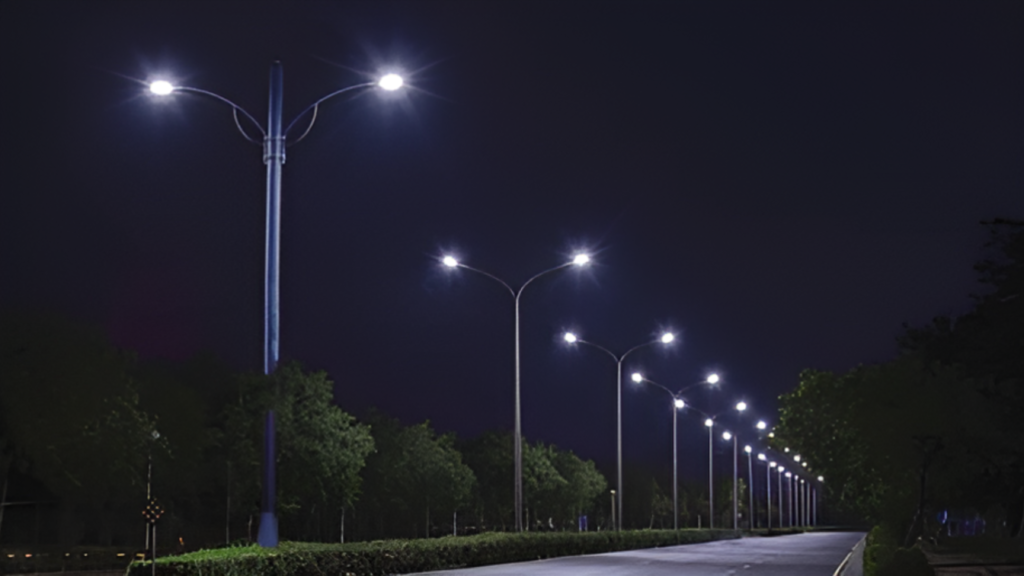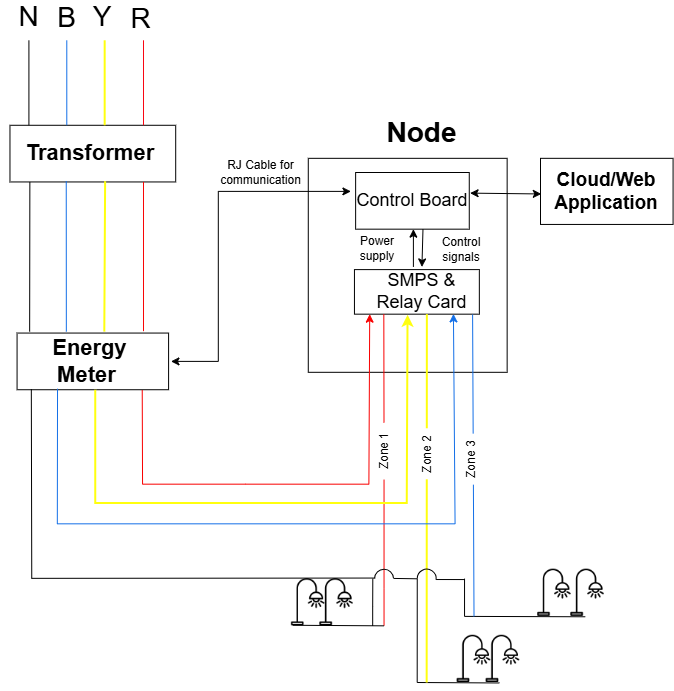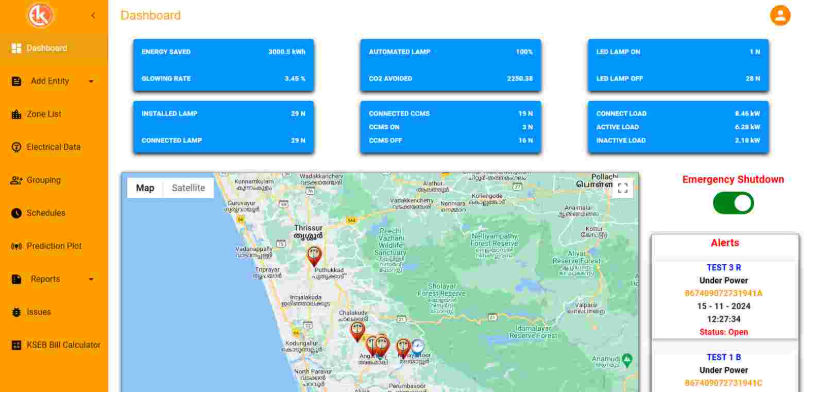Smart Street Light Management System

Overview
The Smart Street Light Management System is designed for smart city integrators by RND Square to optimize the operation, maintenance, and energy consumption of street lighting infrastructure. The system utilizes IoT technology for remote monitoring and control, enabling efficient energy management, real-time fault alerts, issue tracking through customer complaints, energy consumption monitoring, scheduled operation times, voltage and current fault detection. It also includes mechanisms for adding or removing streetlights from the system and provides a platform for customer complaints registration via QR code scanning.
Key Features
- The device that we have installed on each transformer functions as an individual 'NODE'.
- Each phase (R, Y, B) is considered a separate zone.
- Approximately 40-50 streetlights are included in each zone.
Device Deployment

Objectives
- Optimize Energy Consumption
- Improve Fault Detection and Maintenance
- Enhance Public Safety and Reliability
- Enable Remote Monitoring and Control
- Customer Engagement and Satisfaction
- Provide Scalability and Flexibility
- Support Cost Savings and Accurate Billing
- Contribute to Environmental Sustainability
Technologies Used
- DLMS: Device reads necessary electrical parameters such as voltage, current, power, energy, etc., from the energy meter using DLMS (Device Language Message Specification) communication protocol. It is an internationally recognized standard (IEC 62056), ensuring compatibility and interoperability between devices from different manufacturers.
- MQTT: For data transmission as it is easy to implement and can communicate IoT data efficiently.
- React: A JavaScript library for building user interfaces (Frontend Development).
- MongoDB: A database for storing unstructured or semi-structured data.
- Node.js: A server-side JavaScript runtime environment (Backend Development).
- Express: A minimal and flexible Node.js web application framework for building APIs.
Energy Consumption Monitoring
- Real-time tracking of energy usage.
- Graphical representation of current, voltage, power, and energy for detailed monitoring.
- Alerts for current, voltage, and power deviations (e.g., significant spikes or drops).
- Measures energy savings achieved with the new streetlight management system compared to the previous system.
Scheduled Operation
- Each device is considered as a node.
- Each node includes 3 different zones (R, Y, B phases).
- Ability to schedule the operation of streetlights for each zone.
- Zones under different nodes can be grouped together, with separate schedules assigned to each group.
- Each zone can accommodate 4 groups, with each group containing 4 schedules, allowing a total of 16 schedules per zone. A single device can handle up to 48 schedules.
Benefits of Scheduled Operation
- Energy Efficiency: Street lights operate only when needed, reducing energy consumption and lowering electricity bills.
- Cost Savings: Automated systems reduce operational costs and prolong the lifespan of lights.
- Enhanced Safety: Ensures proper lighting during critical hours, improving road safety.
- Consistency and Accuracy: Precise scheduling ensures streetlights turn on/off at the right times.
- Reduced Maintenance Efforts: Automation reduces manual intervention and alerts enable timely maintenance.
- Environmental Benefits: Lower energy consumption contributes to environmental sustainability.
- Integration with Smart City Systems: Adaptive scheduling based on weather or traffic conditions enhances flexibility.
- Improved Public Perception: Reliable street lighting boosts public satisfaction.
Fault Detection
- Device continuously monitors voltage, power, and current levels.
- Automatic detection with instant alert of any significant deviations.
Conditions:
- Over Current
- Under Current
- Over Voltage
- Under Voltage
- Over Power
- Under Power
A daytime alert will be generated when the light is ON during the day.
Remote Monitoring and Control
- Operators can monitor and control streetlights remotely.
- Ability to adjust electrical settings or shut down streetlights from a central system.
Connectivity
The device communicates via 4G/GSM connectivity.
Customer Complaint Registration
- QR code attached to each streetlight.
- Customers can scan the QR code to access a portal and register complaints directly related to a specific streetlight.
- Portal allows operators to easily identify which streetlight has an issue.
Lamp Addition/Removal
Flexibility to add new streetlights or remove existing ones as needed.
Emergency Shutdown
Emergency shutdown functionality to turn off all streetlights.
Graphical Representation
- Interactive graphical displays of current, voltage, power, and energy.
Predictive Plotting and Alerts
- Visualization of energy consumption for the current month.
- Predicted energy consumption alerts are generated when consumption exceeds limits.
DISCOM Calculator
- Dedicated module for calculating energy costs.
- Define the cost per unit of electricity within the module.
- Select the specific node, start date, and end date for the billing period.
Cloud Management
A cloud-based platform aggregates all data from the device, allowing operators to manage, control, and monitor the streetlights remotely.

Results
The system enables efficient energy management, real-time fault alerts, issue tracking, and customer-centric service.
Benefits
- Energy Efficiency: Reduces energy consumption through smart scheduling.
- Enhanced Maintenance: Real-time fault detection minimizes downtime.
- Customer-Centric: QR code-based complaints improve response times.
- Cost Savings: Optimized operation lowers electricity bills.
- Scalability and Flexibility: Adapts to changing infrastructure needs.
- Real-Time Control: Centralized monitoring improves operational efficiency.
Future Enhancements
- AI-Driven Predictive Maintenance: Predict failures using AI algorithms.
- Integration with Smart City Solutions: Coordinate with other urban systems.
Conclusion
The Smart Streetlight Management System offers advanced control, efficiency, and cost savings for streetlight networks, improving service reliability and customer satisfaction.
